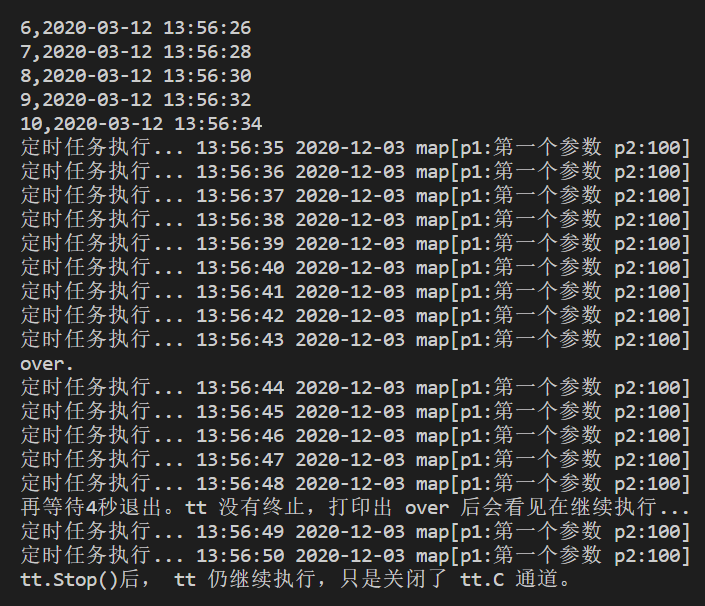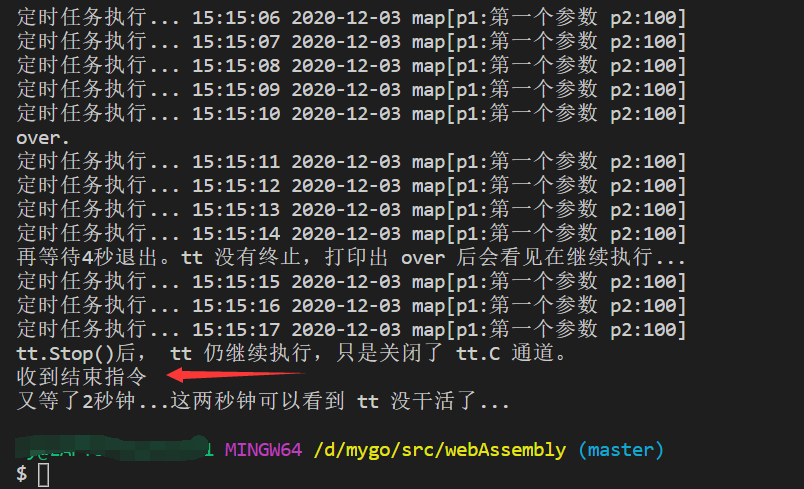Go语言中定时器的使用
GO语言在time包中提供了三种定时器的使用方式:
1.第一种:ticker
1 2 3 4 5 6 | // A Ticker holds a channel that delivers `ticks' of a clock// at intervals.type Ticker struct { C <-chan Time // The channel on which the ticks are delivered. r runtimeTimer} |
通过 time.NewTicker() 创建,这种类型,ticker会不断的按照设定的间隔时间触发,除非主动终止运行。
2.第二种:timer
1 2 3 4 5 6 7 8 | // The Timer type represents a single event.// When the Timer expires, the current time will be sent on C,// unless the Timer was created by AfterFunc.// A Timer must be created with NewTimer or AfterFunc.type Timer struct { C <-chan Time r runtimeTimer} |
通过 time.NewTimer() 创建,这种类型,timer只会执行一次,当然,可以在执行完以后通过调用 timer.Reset() 让定时器再次工作,并可以更改时间间隔。
3.第三种:After()
1 2 3 4 5 6 7 8 9 | // After waits for the duration to elapse and then sends the current time// on the returned channel.// It is equivalent to NewTimer(d).C.// The underlying Timer is not recovered by the garbage collector// until the timer fires. If efficiency is a concern, use NewTimer// instead and call Timer.Stop if the timer is no longer needed.func After(d Duration) <-chan Time { return NewTimer(d).C} |
从代码可以看到,After()其实是Timer的一个语法糖。
下面通过代码演示一下三种方式的使用:
1.Ticker
1 ticker := time.NewTicker(time.Second * 1) // 运行时长 2 ch := make(chan int) 3 go func() { 4 var x int 5 for x < 10 { 6 select { 7 case <-ticker.C: 8 x++ 9 fmt.Printf("%d\n", x) 10 } 11 } 12 ticker.Stop() 13 ch <- 0 14 }() 15 <-ch // 通过通道阻塞,让任务可以执行完指定的次数。
该ticker每1秒触发一次,即ticker.C中每一秒会有一个内容加入,最后通过向ch中写入数字,让程序解除阻塞,继续执行。
2.Timer
1 timer := time.NewTimer(time.Second * 1) // timer 只能按时触发一次,可通过Reset()重置后继续触发。 2 go func() { 3 var x int 4 for { 5 select { 6 case <-timer.C: 7 x++ 8 fmt.Printf("%d,%s\n", x, time.Now().Format("2006-01-02 15:04:05")) 9 if x < 10 { 10 timer.Reset(time.Second * 2) 11 } else { 12 ch <- x 13 } 14 } 15 } 16 }() 17 <-ch
3.After()
1 // 阻塞一下,等待主进程结束 2 tt := time.NewTimer(time.Second * 10) 3 <-tt.C 4 fmt.Println("over.") 5 6 <-time.After(time.Second * 4) 7 fmt.Println("再等待4秒退出。tt 没有终止,打印出 over 后会看见在继续执行...") 8 tt.Stop() 9 <-time.After(time.Second * 2) 10 fmt.Println("tt.Stop()后, tt 仍继续执行,只是关闭了 tt.C 通道。")
4.我们可以利用这些基本的方法,设计自己的定时任务管理。
1 type jobFunc2 func(j *job) 2 3 type job struct { 4 jf jobFunc2 5 params map[string]interface{} 6 ch chan int 7 } 8 9 func NewJob() *job { 10 return &job{ 11 params: make(map[string]interface{}), 12 ch: make(chan int), 13 } 14 } 15 16 func (j *job) Run(t time.Duration) { 17 ticker := time.NewTicker(time.Second * t) 18 go func() { 19 for { 20 select { 21 case <-ticker.C: 22 j.jf(j) 23 case <-j.ch: 24 fmt.Println("收到结束指令") 25 ticker.Stop() 26 break 27 } 28 } 29 }() 30 31 } 32 33 func main() { 34 j := NewJob() 35 j.jf = func(jj *job) { 36 fmt.Println("定时任务执行...", time.Now().Format("15:04:05 2006-02-01"), jj.params) 37 } 38 j.params["p1"] = "第一个参数" 39 j.params["p2"] = 100 40 j.Run(1) 41 42 // 阻塞一下,等待主进程结束 43 tt := time.NewTimer(time.Second * 10) 44 <-tt.C 45 fmt.Println("over.") 46 47 <-time.After(time.Second * 4) 48 fmt.Println("再等待4秒退出。tt 没有终止,打印出 over 后会看见在继续执行...") 49 tt.Stop() 50 <-time.After(time.Second * 2) 51 fmt.Println("tt.Stop()后, tt 仍继续执行,只是关闭了 tt.C 通道。") 52 }
部分执行结果截图:

最后补充一下,通过channel去终止任务的执行。
1 // 阻塞一下,等待主进程结束 2 tt := time.NewTimer(time.Second * 10) 3 <-tt.C 4 fmt.Println("over.") 5 6 <-time.After(time.Second * 4) 7 fmt.Println("再等待4秒退出。tt 没有终止,打印出 over 后会看见在继续执行...") 8 tt.Stop() 9 <-time.After(time.Second * 2) 10 fmt.Println("tt.Stop()后, tt 仍继续执行,只是关闭了 tt.C 通道。") 11 j.ch <- 0 12 <-time.After(time.Second * 2) 13 fmt.Println("又等了2秒钟...这两秒钟可以看到 tt 没干活了...")

在GO语言编写中,要熟练使用 channel。





【推荐】国内首个AI IDE,深度理解中文开发场景,立即下载体验Trae
【推荐】博客园2025新款「AI繁忙」系列T恤上架,前往周边小店选购
【推荐】凌霞软件回馈社区,携手博客园推出1Panel与Halo联合会员
【推荐】轻量又高性能的 SSH 工具 IShell:AI 加持,快人一步
· Android编译时动态插入代码原理与实践
· 解锁.NET 9性能优化黑科技:从内存管理到Web性能的最全指南
· 通过一个DEMO理解MCP(模型上下文协议)的生命周期
· MySQL下200GB大表备份,利用传输表空间解决停服发版表备份问题
· 记一次 .NET某固高运动卡测试 卡慢分析
· .net clr 8年才修复的BUG,你让我损失太多了
· 做Docx预览,一定要做这个神库!!
· 一个开源的 Blazor 跨平台入门级实战项目
· Hangfire Redis 实现秒级定时任务、使用 CQRS 实现动态执行代码
· 微信小程序/H5 调起确认收款界面